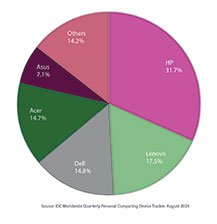
Kaspersky Lab report says that 35 percent of online users in India were attacked by local threats in the year 2020
Kaspersky Lab’s recent report says that 35 percent of online users in India were attacked by local threats in the year 2020. Kaspersky products detected and blocked 200, 238, 155 local threats on the consumer devices between Jan-Dec 2020. The year 2020 witnessed a great chaos due to the COVID-19 pandemic and the increasingly rising number of cyberattacks in India as well as around the world. The increased activity of the nefarious cybercriminal groups became a major concern for the government bodies, enterprises as well as remotely working employees, students and internet users.
From online shopping to e-learning, the number of users online increased multi-fold this year, and so did the cyber threats targeted at them. The KSN report detected and blocked 133,318,878 internet- borne threats in 2020. This affected 35 percent of the internet users in India, placing us on the 43rd rank globally. These were social engineering attacks wherein a user was made to download a malicious file to his/ her device. This happened when cybercriminals made their victim believe that they are downloading a legitimate program in the guise of various scams related to covid19 and other trending issues throughout the year. Remotely working employees and students were vigorously targeted by cybercriminals due to the lack of necessary security solutions on their devices. As of January 2021, the number of global users encountering various threats using popular online learning platforms as a lure reached 270,171 – a 60 percent increase when compared to the first half of 2020.
Dipesh Kaura, General Manager, Kaspersky, South-Asia, said, “As we look forward to building a digital nation, it becomes equally necessary for us to be prepared to fight against the perils of the world wide web. Cybercriminal groups have been more active than ever in 2020 and will continue to try and exploit our vulnerabilities for their financial gains. The best way to avoid being a target is to understand the evolving threat landscape, and develop a robust security system for our devices that will help us in keeping our data safe. The bad guys will also try to lure the internet users through various scams that may be ‘too good to be true’, in such cases it is imperative for the users to be calm, careful and think twice before taking any action that may help the cybercriminals instead”.
Kaura further added, “It is important for well informed and cyber mature online users to spread awareness amongst their family and peers. The policy of ‘each one- teach one’ will help us go a long way in magnifying cybersecurity awareness in India. We urge every individual to share their cyber knowledge as much as possible, and help us bring on the future in a secure Digital India”.
“The threat landscape in India, as well as in the APAC region has been constantly evolving and the threats are becoming more and more sophisticated and targeted in nature. The threats nowadays are not only looming over enterprises and government bodies, but also are targeted at individual internet users, as they can be assumed to be vulnerable and an easy target by the nefarious groups of cybercriminals in order to obtain larger financial gains from them, with very little investment. Most recently, the trend of targeting attacks within the country have also been observed, in order to get hold of some sensitive data that can be misused by the cyber criminals. This definitely calls for an increase in cyber maturity for individual online users and to help them in keeping their valuable possessions secure from potential threats that may be targeted at them”, said Saurabh Sharma, Senior Security Researcher (GReAT), Kaspersky (APAC).
Over 45 percent of the online users in India were targeted by local cyber threats like rootkits and removable tools like malicious USB drives and other offline methods. Brute force attacks on remote desktop protocols (RDPs) also saw a massive increase of 242 percent globally. The number of detections in India alone went as high as 36 million (36356139) in 2020 between January- November.
The share of attacks hosted by servers in India was 0.19 percent that is 7,714,258 incidents in the period January-December 2020 were recorded, which puts India in the 18th place worldwide. While spear phishing and web-skimming were prominent threat vectors in 2020, the cybercriminals also used social media platforms to target their victims and gain financial credentials and other sensitive data.






























































